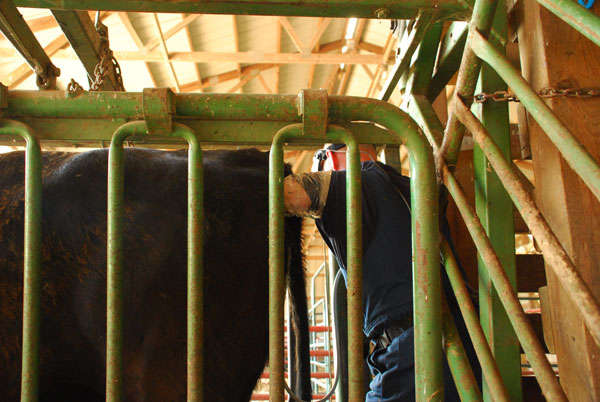Looking to save money? It's foolish to cut preg-checking
October 3, 2016

As cattle margins tighten, there is a temptation to cut costs to improve profits ... and I’m all in favor of it if the cost cutting actually makes your beef business stronger.
The first place to look at cost cutting is in feed cost, which accounts for around 50% of the total cost of keeping a cow. Are you feeding an expensive “convenience feed” that on a cost-per-unit-of-nutrition basis is way out of line compared with other available feedstuffs? Calling your beef herd nutritionist or the nutritionist from the company where you buy your feed or mineral to ask about alternatives should be your first option. Ask if the product you are using is the most cost-effective, or if there is a more economical substitute. Maybe your Extension educator or herd health veterinarian has advanced training in beef nutrition and he or she could answer those questions to help you save money.
As a veterinarian, you might think I would feel health costs are “off limits” in helping to cut overall costs. My father told me when I graduated from veterinary school to “treat all your clients like Mom and me,” and that philosophy has served me well my entire career. If a producer spends money on an unnecessary vaccine, dewormer or other treatment, he needs to know it. There are no sacred cows with being frugal.
One area that would be foolish to eliminate is pregnancy-checking cows. Having a freeloader eat your feed all winter long and produce nothing in return is akin to paying full wages and benefits to an employee who never shows up to work. And not only is the employee contributing zero work, she’s stealing from you by showing up for every meal at your expense. Tell me you wouldn’t fire that worker as soon as she was discovered!

90 stunning fall photos from the ranch
Autumn is here, and ranchers are busy silage cutting, weaning, working calves, preg-checking, and getting ready for winter. See photos here.
The last National Animal Health Monitoring System (NAHMS) report showed only 20.2% of herd owners pregnancy-checked their cows. In herds of more than 200 cows, the numbers were better at 71.7%, but that still leaves many “thieves.” With beef production being already less efficient than poultry or swine production, we must do the things that will keep us competitive with these other sources of protein.
A friend who is a swine veterinarian tells me, “Over 90% of the sow herds are routinely checked, i.e., weekly, that are 500 sows and larger.” What about a hen that stops producing eggs? Ever hear of chicken soup? Beef may never be as efficient as swine or poultry production, but we have to do the easy tasks to keep us competitive and pregnancy checking is easy.
If your total cost of production is $650 per cow per year, and it costs $6.50 to $13.00 per cow to preg-check, that’s only 1% to 2% of your total cost of production. Is skipping this very cost-effective procedure really worth it to save 1% to 2%?
In a 200-cow herd, if the pregnancy test, trip charge and owner labor amounts to $2,500 (many would say that is on the high side), it will take only eight open cows (a 96% pregnancy rate) to make pregnancy checking pay. If your veterinarian also provides value-added services like identifying cows with health issues, staging pregnancies, providing advice on vaccines, deworming, etc., your payback is even greater.
Is this a time to scrutinize every cost? Absolutely, and I suggest doing so regularly. Should every expense be examined to see the impact it will have on herd health and productivity? Absolutely. Just remember not to save a few pennies that will cost you many dollars in the end.
W. Mark Hilton, DVM, PAS, DABVP (beef cattle practice), is clinical professor emeritus, Purdue University College of Veterinary Medicine; and senior technical veterinary consultant, Elanco Animal Health.
You might also like:
Young ranchers, listen up: 8 tips from an old-timer on how to succeed in ranching
13 utility tractors that will boost efficiency in 2016
Burke Teichert: How to cull the right cow without keeping records
3 weaning methods compared; Which one rises to the top?
6 tips for proper electric fence grounding
9 things to include in your ag lease (that you better have in writing!)
About the Author(s)
You May Also Like


.png?width=300&auto=webp&quality=80&disable=upscale)
